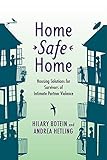Home Safe Home : Housing Solutions for Survivors of Intimate Partner Violence / Hilary Botein, Andrea Hetling.
Material type: TextSeries: Violence Against Women and ChildrenPublisher: New Brunswick, NJ : Rutgers University Press, [2016]Copyright date: ©2016Description: 1 online resource (208 p.) : 3 diagrams and 3 halftonesContent type:
TextSeries: Violence Against Women and ChildrenPublisher: New Brunswick, NJ : Rutgers University Press, [2016]Copyright date: ©2016Description: 1 online resource (208 p.) : 3 diagrams and 3 halftonesContent type: - 9780813585840
- 9780813585871
- Abused women -- Housing -- United States
- Family violence -- United States
- Women -- Violence against -- United States
- SOCIAL SCIENCE / General
- house, home, shelter, living, safety, security, IPV, domestic abuse, domestic assault, abusive husband, abusive wife, abusive, homeless, homelessness, IPV survivor, partner violence, intimate partner violence
- 363.5/9 23
- HV1445 .B68 2016
- HV1445 .B68 2016eb
- online - DeGruyter
- Issued also in print.
| Item type | Current library | Call number | URL | Status | Notes | Barcode | |
|---|---|---|---|---|---|---|---|
 eBook
eBook
|
Biblioteca "Angelicum" Pont. Univ. S.Tommaso d'Aquino Nuvola online | online - DeGruyter (Browse shelf(Opens below)) | Online access | Not for loan (Accesso limitato) | Accesso per gli utenti autorizzati / Access for authorized users | (dgr)9780813585871 |
Frontmatter -- Contents -- Preface and Acknowledgments -- Introduction -- PART ONE. Why Long-Term Housing for Survivors of Intimate Partner Violence? -- 1. "Why Doesn't She Leave?" -- 2. "How Does Housing Help?" -- PART TWO. The Current Policy and Service Environment: How Did We Get Here? -- 3. First Stop -- 4. Mismatch between U.S. Social Policy and Intimate Partner Violence -- PART THREE. An Evolving Approach: Long-Term Housing -- 5. National Overview -- 6. Developing Program Theory and Goals -- 7. Survivor Perspectives on Program Theory and Models -- PART FOUR. Next Steps? -- 8. Moving Forward -- Epilogue -- Appendix: Methods -- Notes -- Bibliography -- Index
restricted access online access with authorization star
http://purl.org/coar/access_right/c_16ec
Housing matters for everyone, as it provides shelter, security, privacy, and stability. For survivors of intimate partner violence (IPV), housing takes on an additional meaning; it is the key to establishing a new life, free from abuse. IPV survivors often face such inadequate housing options, however, that they must make excruciating choices between cycling through temporary shelters, becoming homeless, or returning to their abusers. Home Safe Home offers a multifaceted analysis that accounts for both IPV survivors' needs and the practical challenges involved in providing them with adequate permanent housing. Incorporating the varied perspectives of the numerous housing providers, activists, policymakers, and researchers who have a stake in these issues, the book also lets IPV survivors have their say, expressing their views on what housing and services can best meet their short and long-term goals. Researchers Hilary Botein and Andrea Hetling not only examine the federal and state policies and funding programs determining housing for IPV survivors, but also provide detailed case studies that put a human face on these policy issues. As it traces how housing options and support mechanisms for IPV survivors have evolved over time, Home Safe Home also offers innovative suggestions for how policymakers and advocates might work together to better meet the needs of this vulnerable population.
Issued also in print.
Mode of access: Internet via World Wide Web.
In English.
Description based on online resource; title from PDF title page (publisher's Web site, viewed 30. Aug 2021)


